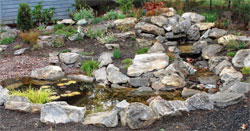By Hosea Omole
Okayama City in the Chugoku region, south west of Japan is home to the famous Korakuen Garden — literally translating to "garden of pleasure after". Korakuen gardens flow with serenity. Extensive lawns carpet the gentle slopes, extending time and again into the quiet waters to form miniature islands. The lotus pond, as if in compensation, stretches into the valleys, only breaking to form a waterfall or cascade over groups of rocks that dot the virgin landscape. Wide paths crisscross the lawn leading to occasional teahouses strategically oriented to take in the best views.
The Karakuen Garden embodies the concepts of Japanese gardens that are renowned world over for their therapeutic value. Their tranquil and serene environments evoke contemplation and meditation that soothes the mind and restores the spirit.
Should you ponder recreating these values in your yard, here are some elements that you could consider:
Walkways, bridges
Respect for nature is the overriding philosophy behind the design of Japanese gardens. All manmade elements are made to look as natural as possible.
 |
Stones of various shapes and sizes creatively arranged to give the garden a natural look. Photos: Courtesy
|
The paths are not an exception. Informal paths made of natural stone and sand lead the visitor lazily around the garden. They meander, climb and fall to facilitate slow movement and let the viewer partake of nature’s perfection.
Paths deliberately intersect streams and ponds. Bridges and stepping-stones placed across such intersections are thus important features in Japanese gardens. Made of wood and stone, the bridges blend easily into the natural environment. Mosses are encouraged to grow over the stones to complete the concept of oneness with nature.
Landscape structures
Paths lead to pavilions and teahouses, which are constructed using oriental architectural concepts. Such garden structures complete with Japanese style roofs are strong statements in the design.
They are mainly wooden with shingle roofs, again because such materials are natural. Tall trees, shrubs and climbers are planted close to subdue the structure.
No structure is allowed to defy nature. All are proportional to the rest of the natural landscape. The size of individual elements of the structure as well as the overall size should sit well with the rest of the garden’s details.
Stay informed. Subscribe to our newsletter
Ornaments
In Japanese gardens, functional elements double as ornaments. Wells, sculptures, stone lanterns and benches are some of the common examples.
Stone and stone arrangements were traditionally used as ornaments to represent geological features. This concept has now become more abstract and the stone arrangement may just be a work of art, not necessarily symbolising Mt Kenya.
Overall, ornaments are made of natural materials and must conform to the natural values in colour, size and arrangement. They are placed randomly and strategically to form centrepieces for the different garden space.
The writer is a professional landscape architect.
 The Standard Group Plc is a
multi-media organization with investments in media platforms spanning newspaper
print operations, television, radio broadcasting, digital and online services. The
Standard Group is recognized as a leading multi-media house in Kenya with a key
influence in matters of national and international interest.
The Standard Group Plc is a
multi-media organization with investments in media platforms spanning newspaper
print operations, television, radio broadcasting, digital and online services. The
Standard Group is recognized as a leading multi-media house in Kenya with a key
influence in matters of national and international interest.
 The Standard Group Plc is a
multi-media organization with investments in media platforms spanning newspaper
print operations, television, radio broadcasting, digital and online services. The
Standard Group is recognized as a leading multi-media house in Kenya with a key
influence in matters of national and international interest.
The Standard Group Plc is a
multi-media organization with investments in media platforms spanning newspaper
print operations, television, radio broadcasting, digital and online services. The
Standard Group is recognized as a leading multi-media house in Kenya with a key
influence in matters of national and international interest.






